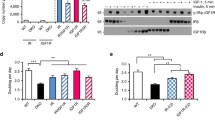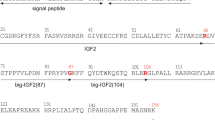Abstract
LONGTMR3IGF-I, an analogue of insulin-like growth factor (IGF)-I, was specifically engineered for use in biopharmaceutical protein production in mammalian cells. LONGTMR3IGF-I is capable of supporting the growth and survival of Chinese hamster ovary cells in serum-free media at concentrations at least 200-fold lower than required for insulin. LONGTMR3IGF-I also acts as a more potent growth and survival factor than either insulin or native IGF-I in SF culture of human embryonic kidney (HEK293) cells. To investigate the basis of the enhanced potency of LONGTMR3IGF-I we have examined the mechanism of action of these mitogens in HEK293 cells. All mitogens tested were found to activate the TypeI IGF receptor (IGF-IR) and insulin receptor (IR) in a dose-responsive manner. However, the level of activation of both receptors after stimulation with LONGTMR3IGF-I, at lower concentrations, was greater than with either insulin or IGF-I. The greater potency of LONGTMR3IGF-I in activating the IR, despite having a low affinity for IRs, suggests the presence of heterotetrameric IGF-IR/IR dimers. Interestingly, the decrease in IGF-IR activation at higher concentrations of LONGTMR3IGF-I suggests that the dose-response curve may be bell-shaped.
Similar content being viewed by others
References
Francis, G. L., Ross, M., Ballard, F. J., et al. (1992) Novel recombinant fusion protein analogues of insulin-like growth factor (IGF)-I indicate the relative importance of IGF-binding protein and receptor binding for enhanced biological potency. J. Mol. Endo. 8, 213–223.
Yandell, C., Lawson, J., Butler, I., et al. (2004) An analogue of IGF-I. An potent substitute for insulin in serum-free manufacture of biologics by CHO cells. BioProc. Int. March, 56–64.
Morris, A. E. and Schmid, J. (2000) Effects of insulin and LongR3 on serum-free Chinese Hamster Ovary cell cultures expressing two recombinant proteins. Biotechnol. Prog. 16, 693–697.
Buckler, A. and Al-Rubeai, M. (2005) Enhanced cell proliferation of the HEK293 cell line and Adenovirus productivity in serum free medium by addition of a genetically modified insulin growth factor. 19th ESACT Meeting, Harrogate, UK, p. 185.
Soos, M. A., Field, C. E., and Siddle, K. (1993) Purified hybrid insulin/insulin-like growth factor-I receptors bind insulin-like growth factor-I, but not insulin, with high affinity. Biochem. J. 290, 419–426.
Florini, J. R., Ewton, D. Z., Falen, S. L., and Van Wyk, J. J. (1986) Biphasic concentration dependency of stimulation of myoblast differentiation by somatomedins. Am. J. Physiol. Cell Physiol. 250, C771-C778.
de Meyts, P., Roth, J., Neville, D.M., Jr., Gavin, J. R. 3rd, and Lesniak, M. A. (1978) Insulin Interactions with its receptors: experimental evidence for negative cooperativity. Biochem. Biophys. Res. Comm. 55, 154–161.
Author information
Authors and Affiliations
Corresponding author
Rights and permissions
About this article
Cite this article
Voorhamme, D., Yandell, C.A. LONGTMR3IGF-I as a more potent alternative to insulin in serum-free culture of HEK293 cells. Mol Biotechnol 34, 201–204 (2006). https://doi.org/10.1385/MB:34:2:201
Issue Date:
DOI: https://doi.org/10.1385/MB:34:2:201




